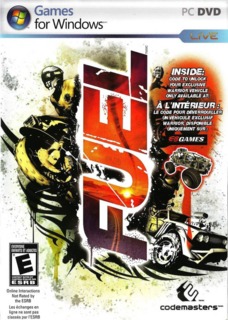A game misunderstood even by the developers themselves, Fuel delivers unforgettable journeys rather than arcade racing.
It's strange really, but the potential of the game's storyline was immense, judging from arcade standards. In the not-too-distant future global warming, as well as severe climatic changes devastate America, forcing people to evacuate to other continents. Everybody leaves, except for a bunch of hot-head racers who see the deserted lands of USA as an enormous source for their never-dieing wish for competing. However, the weather also worked hard on crushing the world's economy, making fuel the most valuable resource, hence the name. The participants treat fuel as an official currency, and race across canyons, farms and tornado valleys just to get another barrel of it.
It sounds great, maybe even like a Fallout where RPG is swapped by fast vehicles. But the game does little to actually deliver the story or expand it somehow. The world is deserted, yes, but signs of cataclysmic events occur only in scripted tornado races or when you stumble across a burning forest. Other than that, it's just lush green fields and peaceful landscapes bathing in the rays of the sun. There is no character development, not that most racing games need them, anyway.
But as many have predicted, nothing saved Fuel from the disastrous syndrome all open-world games possess: The bigger the space, the more boring the game becomes. And Fuel is plain enormous. For once you don't get a glimpse of doubt at the 5000 square miles description of the sandbox, because from the first seconds you are thrown into the never ending loop of mountains, fields, canyons, snowy peaks and utter repetitiveness. The challenge races offer little variation apart from scripted weather effects, the vehicles handle generally well and are divided into several categories, and that's it. Completing challenges opens new areas to compete in, as well as even more transports for traversing. Going online makes other players pop-up in freeride, and let's you compete in custom races or just roam around with them.
However, freeride is not that useless. You can collect fuel barrels(By hitting them), hunt for new paint bonuses and discover Vista points, places from where the overwhelming world looks even bigger. Moving around the state can sometimes prove difficult due to a weirdly complicated GPS system. It is context-sensitive: if you drive on asphalt the arrows indicate the optimal route to your marked destination via roads, if you're rallying through offroads it will re-orient on those types of cover, and if you're ignoring roads altogether it'll just show the direct way to the target, often telling you to ride over mountains or cross lakes. It is very hard to get used to it.
Not that traversing all that space can be unpleasant, thanks to a great graphics engine which manages to deliver eye-popping visuals, impressive draw distance, superior lighting model reinforced with day/night cycle and masterful optimization altogether, which really seams like a feat considering the scale of the terrain. The sceneries have a peaceful, almost meditative feel to them, and weather effects really look labored upon. However, after having a closer look you'll discover cranky driver animation, sprite-grass rotating to fit the camera angle, and complete frustration regarding the vehicle physics. If you don't crash after hitting a tree at 120 km/hr, you'll jump up and backwards several meters.
But if you look over all of these minor, but annoying flaws, you get a game which is great at one thing: simulating a meditative traverse across endless plains. The atmosphere is further deepened by soothing guitar tunes accompanying the player, as well as mesmerizing sunsets occurring every now and then. The vehicles tend to sound authentic, however judging from their nondescript origins it's impossible to measure exactly how believable they sound, or even look. But the illusion of a deserted, beautiful world filled with custom-made vehicles and daredevil drivers is portrayed more than decently.
It's the summary of all these elements that uncovers the bitter truth. The game is not good or even tolerable at everything the developers had promised us it would be: we got an absolutely different product, definitely not Codemasters-styled, capable of only giving us the illusion of an enormous world calling us for exploration, and not adrenaline-filled races and full speed crashes on the track. Not something most people payed for. Nevertheless, it is good at what it does, and that fact coupled with the enormous labor the developers have put in this game gives it a solid title as a game for the few.
As for the arcade racing part, well, what can we say, it's in desperate need of fuel.

